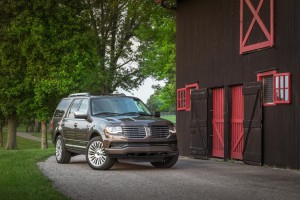
The 2015 Lincoln Navigator is fighting for attention in an increasingly crowded luxury SUV market segment.
The Lincoln Navigator has been around so long that one might think it was named by Abe Lincoln. However, the nearly abolished full-size luxury SUV soldiers on until its replacement arrives some time next year.
Navigator was slated to get the ax during former Ford CEO Alan Mulally’s push to get streamline Ford Motor’s product line-up. It was the effort that dismantled Mercury entirely and the Navigator was on the chopping block until Ford officials realized that Cadillac and other luxury marques were going to have a full-size luxury SUV available.
However, as much as Navigator is showing its age, it’s still remarkably appealing. The current version got an exterior makeover for 2015 that is clearly an evolution, among other things adopting the split-wing grille that debuted on the latest version of the Lincoln MKZ.
The Navigator has always been an appealing vehicle on the outside, but it is the luxury appointments on the inside as well as what’s under the hood that has either made or broken the full-size SUV.
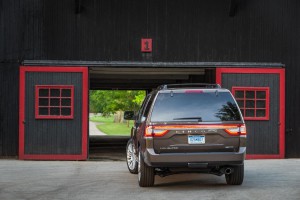
For 2015, Navigator got a refreshed design for the rear lift gate, which includes a standard rear camera.
Powering this year’s iteration is a 3.5-liter EcoBoost V6 putting out 380 horsepower. The EcoBoost’s appearance as a power plant for the Navigator might have some traditionalists screaming for their V8s. However, the V6 delivers more than enough oomph for the big ute. Acceleration is smooth and getting into traffic is no problem with the EcoBoost.
Perhaps most important is the improvement in gas mileage one gets when driving the EcoBoost-powered beast: 17 mpg combined, including 20 mpg on the highway. Our test vehicle actually averaged a little better than 18 mpg during our week.
If saving a few pennies on gas is less important than what you can pull with your luxe SUV, the Navigator has that covered too as maximum towing capacity is a class-leading 9,000 pounds for the standard length 4×2 model. The 4×4 version comes in at 8,600 pounds. The longer “L” model sees it drop to 8,500 pounds with two-wheel drive or 8,300 with four-wheel drive.
On the inside, the Navigator provides occupants all of the usual appointments one would expect from a full-size luxury SUV: leather seats that are heated and cooled for those fortunate enough to be in the front seats.
Back seat denizens needn’t feel under appreciated. While they only get heated seats, they also get plenty of room and that “room” is wrapped in leather as well. The Navigator features three rows of seats, including the fold-flat third row, which does exactly that at the push of a button.
(Lincoln MKS getting axed in 2016. For more, Click Here.)
Although, I was a bit surprised by one aspect of the system. In order to get the seats to fold flat, before you push the buttons, you have to make the head rests fold down…by pulling on a thin strap. It seems like that should be part of the push-button system as it is with key competitors.
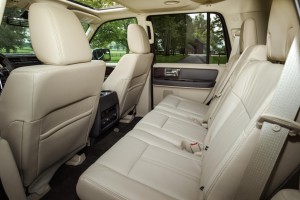
The Navigator features plenty of room for passengers with options for a split bench or captains chairs.
Like most luxury vehicles these days, technology is a key contributor to the experience. The Navigator does a fair job here with some key gaps in its active safety options. Some of the technology is simple: like a passive entry system that senses the key fob and unlocks the doors and illuminates what Lincoln calls “welcome mats.” Small lights mounted in the side mirrors light up the ground next to the door using the Lincoln symbol allowing you to better see the area around the door.
The brand’s oft-derided MyLincoln Touch system continues to improve. Ford has spent several years tweaking the system for both of its brands. While the first iteration was cause for consternation, the current version is a big improvement. It’s easier to use, the functions are easy to decipher and the voice recognition system, to me, is the best in the industry.
When not using the voice-command options, the driver connect system allows drivers to use touch screen controls to make phone calls, play music, manage the navigation system or set cabin temperature. The system includes a 4.2-inch LCD screen in the instrument cluster, an 8-inch touch screen in the center stack and traditional knob controls for easy operation.
(Click Here for details Ford allowing 3D printers to duplicate vehicles.)
Of course, safety technology is a critical component as well. Navigator has a standard Blind Spot Information System signals when another vehicle is detected in an adjacent lane behind either rear wheel. Navigator also has a standard rearview camera, which displays a color image on the 8-inch touch screen to give the driver a better view when driving in reverse.
However, one area where the Navigator falls way short – especially when compared to the Mercedes-Benz GL and recently updated Cadillac Escalade – is in high-tech safety technology, such as active cruise control, lane-keeping assist and automatic emergency stopping. In an era where we are hurtling toward self-driving vehicles, it’s a noticeable deficiency for the current model Navigator.
Perhaps the bottom line is what will it cost to get behind the wheel of the somewhat-long-in-the-tooth luxury beast? Prices for the 2015 Navigator start at $61,480, with four-wheel-drive adding $3,575 to the price tag. If you continue adding items, you can hit $75k, which puts it in the ballpark with its competitors.
(To see more about Ford readying to launch the third generation of Sync, Click Here.)
The 2015 Lincoln Navigator’s what I call a “kick save.” It gets the job done in a pinch, but it’s less than ideal. The 2015 Navigator gives me hope for the next-generation – whether is 2016 or 2017 – Lincoln Navigator.

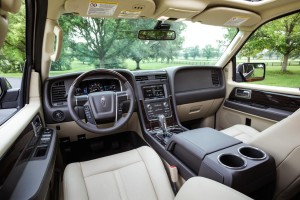
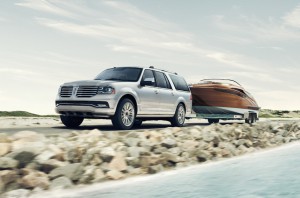
Obviously the reason why the current Navigator lacks the passive safety extras is because it’s being replaced and the expense for one year simply is not practical.